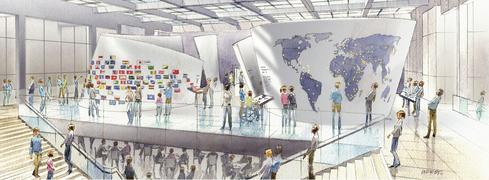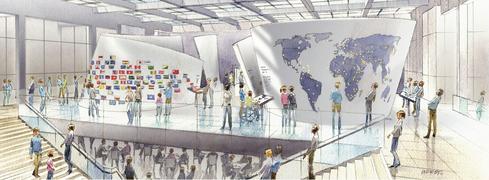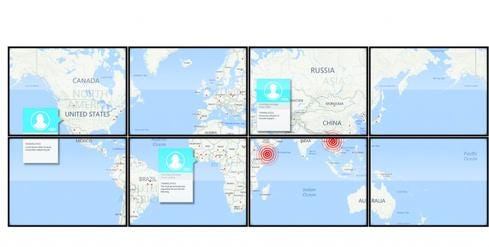Microsoft Brings Tech To US Diplomacy CenterMicrosoft Brings Tech To US Diplomacy Center
A $1 million contribution from Microsoft will help bring new technology to a museum focused on American diplomacy.


Robots Unleashed: 4 Reasons We're Not Doomed
Robots Unleashed: 4 Reasons We're Not Doomed (Click image for larger view and slideshow.)
Earlier this year, Microsoft announced a $1 million donation to assist in the development of a high-tech interactive exhibit at the United States Diplomacy Center (USDC). The Department of State will provide the space, staff, and security for the museum, which is intended to honor the history and significance of diplomacy in America.
There are plenty of museums across the United States dedicated to helping visitors learn more about the history of America and its military, but so far none that focus on diplomacy. This is expected to change with the USDC, an effort being driven by the Diplomacy Center Foundation (DCF). The DCF was created to support the museum project and has since raised $38 million for its cause.
The goal behind the museum, which is currently undergoing development, is to provide information and collaborative exhibits to teach more about a topic that isn't often discussed among the public. Visitors will learn about the history of diplomacy, details of diplomatic careers, and the current state of diplomacy. They'll also have the chance to communicate with experts in different parts of the world.
Working for the US government can be dangerous for Americans abroad, Judith Bryan, senior advisor for content at the USDC, told information in an interview. "We want to honor them and explain what they do," said Bryan, who served as a Public Diplomacy Officer/Foreign Service Officer for 25 years before she began her work managing the museum's exhibits.
[ Tech history is still being made. Read: Bill Gates: Microsoft Turns 40 ]
As with many modern museums, technology will have a critical role in shaping how visitors learn at the USDC. "We hope that our museum will have either state-of-the-art, or in some cases next-generation, technology," said USDC director Kathy Johnson. She said she hopes that visitors will have access to a range of different technologies and, ultimately, an experience that is "informative, educational and highly interactive."
The USDC will be separated into four distinct halls. Two will revolve around themes including the history of diplomacy and diplomacy today; a third will serve as an education center, where students can practice acting in diplomatic situations. A fourth hall will contain visitor amenities such as a bookstore, café, and movie theater.
Figure 1: 
(Image: USDC)
Johnson is a diplomat by profession and worked for the Assistant Secretary of State before taking on her current role as museum director. Though she said she's not a tech expert, she has been drawing inspiration from a variety of modern museums to determine which technologies the USDC should embrace.
She cited the New York-based Museum of American Finance as one that uses technology to engage visitors with a somewhat dull subject. One exhibition featured an interactive board containing the faces of people in financial history. Touching a face enabled the visitor to hear the voice of each person explaining who they were and what they did.
"It really was an effective way to bring technology to history in what might otherwise be a very dry topic," Johnson said.
Another source of inspiration is New York's National September 11 Memorial & Museum, an educational and historical center built to honor victims and examine 9/11 and its global significance. The museum contains an interactive exhibit focusing on the "Last Column," a pillar where first responders wrote their company name as they entered the building. Visitors can point and click through several layers to learn about the first responders and their roles, she said.
Next Page: "Diplomacy is Everywhere, 24/7"
Attend Interop Las Vegas, the leading independent technology conference and expo series designed to inspire, inform, and connect the world's IT community. In 2015, look for all new programs, networking opportunities, and classes that will help you set your organization’s IT action plan. It happens April 27 to May 1. Register with Discount Code MPOIWK for $200 off Total Access & Conference Passes.
"It's done in a very dignified setting," Johnson continues, "but allows visitors to interact through technology in a quiet way to understand what those groups did." She hopes to achieve a similar effect at the USDC.
The DCF is working to collaborate with private sector donors to combine technical expertise with diplomatic vision, and the role of technology will vary throughout the museum. Microsoft in particular will have a key presence in Hall 1, which will dive into the current state of diplomacy. The Foundation is anticipating further discussions with Microsoft to showcase its global relationships, says Johnson.
In a blog post on the partnership, Microsoft's EVP and chief strategy officer Mark Penn shares the company vision for its "Diplomacy is Everywhere, 24/7" exhibit. Devices like Surface Hub touch screens, Skype Translator and Bing Maps are three tools that visitors can use to "virtually play the role of diplomat," Penn writes. "They'll travel where diplomats travel, talk with foreign diplomatic counterparts, and make the decisions diplomats make every day around the world," he continues.
Figure 2: 
(Image: Microsoft)
The vision includes a digital "Diplomacy Wall" that will allow visitors to interact with real-life scenarios and learn about the issues that diplomats face each day. They can also use the map to see where the US has a diplomatic presence around the world, learn about international organizations, and visualize where the U.S. is working on various global issues like wildlife trafficking and HIV/AIDS, says Bryan.
She, too, sees technology as a critical component for how the museum will engage and educate a broad audience of people, from passively interested adults to students who want to pursue diplomatic careers. Current ideas include a pen that can be used to download information from exhibits and video capabilities to capture visitors speaking at a podium as diplomats would. For students, Bryan would like to build glass-enclosed classrooms in which they can chat with foreign peers or diplomats in countries they're studying at that time.
The museum will also highlight how technology has influenced diplomacy over time and how diplomats leverage technology each day. Bryan hopes to teach visitors how tools like video conferencing and social media shape global communication.
In order to bring these visions to life, Bryan is recruiting participation from active and retired diplomats, citizen diplomacy partners, and student interns. "We're trying to get as much input as we can to make sure that we're on target," she says. "We want it to be inclusive." Input is coming from all corners of US government including the departments of agriculture, commerce, and homeland security.
Attend Interop Las Vegas, the leading independent technology conference and expo series designed to inspire, inform, and connect the world's IT community. In 2015, look for all new programs, networking opportunities, and classes that will help you set your organization’s IT action plan. It happens April 27 to May 1. Register with Discount Code MPOIWK for $200 off Total Access & Conference Passes.
About the Author
You May Also Like






